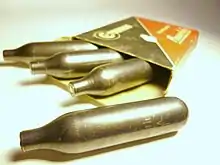Powerlet
A Powerlet cartridge, commonly referred to as a CO
2 charger, is a small disposable metal gas cylinder holding 8–12 grams (0.28–0.42 oz) of liquid CO
2 and often a small quantity of lubricating oil, used as a pneumatic power source for certain air guns, airsoft guns, paintball guns, and for quick inflation of various devices such as a personal flotation device.[1] Originally developed and the trademark owned by Crosman Corporation and introduced to the market in 1954, the Powerlet CO
2 cartridge has become the dominant source of power for inexpensive, rapid fire air guns from many manufacturers.

Typically manufactured from the same steel alloys and using the same metal spinning fabrication processes as much larger refillable gas cylinders, a Powerlet cartridge typically provides 20 to 40 shots in an airgun, depending on the gun and environmental conditions. The first 10 shots from a new bottle are consistent, with subsequent shots losing power. For paintball markers, fewer shots are produced due to the greater weight of the paintball compared to an airgun projectile.
For modern paintball guns, this technology is considered outdated, as they cannot fire as many shots as a modern large-capacity CO
2 tank can provide, though some still use Powerlet cartridges for stock paintball. They are also still favored for paintball pistols, for players wishing to run "light" with considerably less weight. Because liquid CO
2 needs to vaporize to gaseous form to be usable, latent heat is absorbed every time a shot is discharged, cooling the cannister. When discharging repeatedly, the temperature within the Powerlet cannister can drop low enough to affect the vapor-liquid equilibrium and reduce the vapor pressure significantly. The drop in output pressure (known as the "working pressure") not only can affect the ballistic performance, but also can cause the gun to "freeze up" and cease operating completely due to insufficient pneumatic force, until the cannister warms back up again. This causes a problem due to the rapid-fire nature of many competitive paintball skirmishes, so the high-pressure air (HPA, or "N2") systems are more commonly used.
See also
References
- Luis E. Martinez; Luis E. Martinez Med (June 2008), Force-On-Force Police Training Using Airsoft: A Manual for the Law Enforcement Trainer on the Use of Airsoft Non-Lethal Technology, OUTSKIRTS PRESS, pp. 10–, ISBN 978-1-4327-2684-3